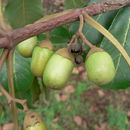mk
имиња во трошки


Vitex doniana ist ein Baum in der Familie der Lippenblütler aus West-, Zentral- und Ostafrika bis in südliche Afrika.
Vitex doniana wächst als laubabwerfender Baum bis 25 Meter hoch. Der Stammdurchmesser erreicht bis über 100 Zentimeter. Die bräunliche bis grau-braune Borke ist rissig bis furchig und abblätternd oder schuppig.
Die einfachen und gestielten Laubblätter sind gegenständig und zusammengesetzt handförmig mit 3–7 Blättchen. Der Blattstiel ist bis 20 Zentimeter lang. Die kurz gestielten, ganzrandigen, ledrigen und fast kahlen Blättchen sind 6 bis 14 (bis 25) Zentimeter lang und 3 bis 8 (bis 10) Zentimeter breit.[1] Die Blättchenstiele sind bis 2,5 Zentimeter lang. Die Blättchen sind eiförmig bis elliptisch oder verkehrt-eiförmig und an der Spitze sind sie abgerundet bis eingebuchtet oder seltener spitz.
Es werden achselständige und kleinere, mehr oder weniger rostig behaarte, länger gestielte Zymen gebildet. Die zwittrigen und kurz gestielten, weißen bis hellvioletten, -purpurfabenen kleinen Blüten sind fünfzählig mit doppelter Blütenhülle. Der bis 5 Millimeter lange, becherförmige Kelch mit kleinen Zipfeln ist außen rostig behaart. Die Kronblätter sind in der typischen Form der Lippenblütler, sie sind in einer bis 6–8 Millimeter langen Röhre verwachsen mit zweilippigen Lappen, der mittlere Lappen der Unterlippe ist vergrößert und im unteren Teil gelblich behaart, bis 4,5 Millimeter lang und länger wie die anderen 4, bis 3 Millimeter langen Lappen. Die 4 Staubblätter sind didynamisch und etwas vorstehend. Der vierkammerige Fruchtknoten ist oberständig mit einem längeren Griffel.
Es werden 2–3 Zentimeter große, rundliche, mehrsamige und dunkel- bis schwarz-violette, mehr oder weniger beige gepunktete, glatte Steinfrüchte mit bleibendem Kelch gebildet. Der holzige Steinkern enthält bis zu 4 Samen.
Die Chromosomenzahl beträgt 2n = 32.
Die Früchte sind essbar und werden roh, gekocht oder kandiert konsumiert. Aus den Samen kann ein Öl gewonnen werden
Die Rinde, Wurzeln und Blätter sowie die Früchte werden medizinisch genutzt.
Das mittelschwere, weiche und nicht beständige Holz wird für einige Anwendungen genutzt. Es ist bekannt als African oak, Meru oak oder Vitex.
Vitex doniana ist ein Baum in der Familie der Lippenblütler aus West-, Zentral- und Ostafrika bis in südliche Afrika.
Vitex doniana is a tree native to the Afrotropics. Its fruits are one of several fruits called black plums. This tree is often grown for its fruits.[1][2]
It grows to 4–8 metres (13–26 ft), and rarely up to 15 metres (49 ft). Its fruits are at most 2.5 centimetres (31⁄32 in) in length.[2] V. doniana is found at altitudes of 0–1,800 metres (0–5,906 ft)[2] in Ethiopia, Nigeria, Eswatini, Tanzania, Uganda and Zambia.[3] The insect Rastrococcus invadens is a pest to this plant.[3]
V. doniana is known as plem in Ethiopia, uchakoro in Nigeria, mfudu and mfuu in Eswatini, mfuu in Tanzania, munyamazi and yuelo in Uganda and kashilumbalu in Zambia.[3]
V. doniana is one of the few plants notable for its phytoecdysteroid content, Ochieng et al. 2013 finding it is one of the few with more than 0.001% by dry weight.[4] Specifically they find 21-hydroxyshidasterone, 11b-hydroxy-20-deoxyshidasterone and 2,3-acetonide-24-hydroxyecdysone.[5]
Vitex doniana is a tree native to the Afrotropics. Its fruits are one of several fruits called black plums. This tree is often grown for its fruits.
Vitex doniana est une espèce d'arbres de la famille des Lamiaceae et du genre Vitex, répandue dans toute l'Afrique intertropicale, présente également aux Comores et à La Réunion.
Communément appelée « prunier noir », on lui connaît de nombreux noms locaux, tels que : oum dougoulgoun (arabe), bi (baya), galbiki (foulfouldé), ɗinya (haoussa), ãadga (mooré), shike koma, garbo (kapsiki), zekad (mafa), seked (mofu)[3] et kogonin fin (bambara).
En raison de son aspect sphérique et noir, la graine comestible est également nommée « prune noire », « bois de bouchon », « grain bouchon », « graine bouchon ». Ces dernières appellations sont communes sur l'île de La Réunion où l'espèce a été introduite en 1839 par le botaniste français Claude Richard[4].
Les fruits, tout d'abord verts, mûrissent de mai à novembre et deviennent noirs et sucrés. L'arbre qui la porte peut atteindre 10 à 15 mètres. Elle est présente en Afrique et dans l'Océan Indien. Sur l'île de la Réunion, on la rencontre généralement dans les bas de l'île, souvent à l'état d'arbre isolé. Il est présent dans les grands jardins publics comme le Musée de Villèle, le jardin de l'État à La Réunion ou en alignement le long des routes comme à l'Anse des Cascades.
Tronc de V. doniana au jardin botanique et zoologique de l'université d'Abomey-Calavi (Bénin)
Fruits, avec échelle (Sénégal)
La graine, comestible[6], peut fournir une boisson sucrée et possède des vertus médicinales. En Afrique, les Gude fabriquent une mélasse destinée à aromatiser les plats à partir de la pulpe de ses fruits[7].
Les jeunes feuilles de Vitex doniana peuvent être utilisées comme tisane pour faciliter la digestion mais aussi pour le traitement de l'anémie et de la dysenterie.
Au Burkina Faso, cette plante est également utilisée pour traiter les règles douloureuses[8].
Résistant aux termites, le bois est utilisé pour la construction, la menuiserie (pirogues, tambours, petits objets) et en tant que combustible[3].
Vitex doniana est une espèce d'arbres de la famille des Lamiaceae et du genre Vitex, répandue dans toute l'Afrique intertropicale, présente également aux Comores et à La Réunion.
Vitex doniana là một loài thực vật có hoa trong họ Hoa môi. Loài này được Sweet miêu tả khoa học đầu tiên năm 1826.[1]
Vitex doniana là một loài thực vật có hoa trong họ Hoa môi. Loài này được Sweet miêu tả khoa học đầu tiên năm 1826.